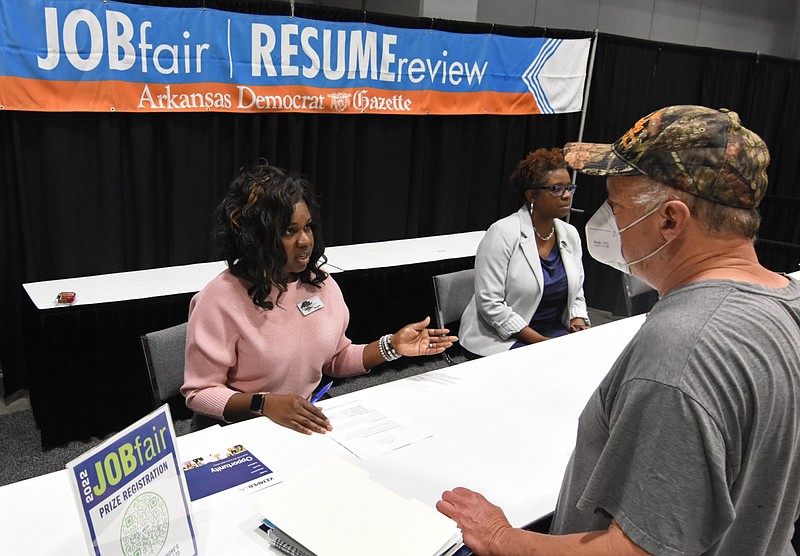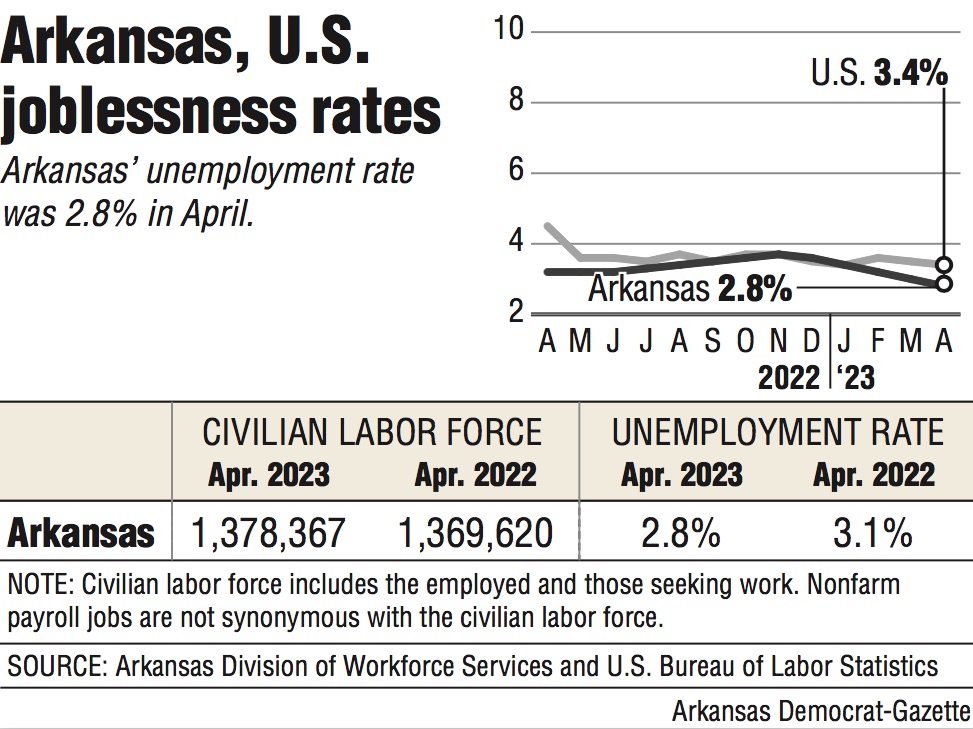Employment in Arkansas increased in April for the seventh consecutive month, generating another unemployment record low at 2.8% and achieving an all-time high in the number of workers with jobs. The state also registered a new low in the number of unemployed.
Unemployment dropped from 3% in March and is well below the U.S. rate of 3.4%, the Arkansas Division of Workforce Services reported Friday. More Arkansans are out searching for work, boosting the labor force by 2,945 though participation is lower than it was a year ago.
Leisure and hospitality took the spotlight in April, adding 6,900 jobs in the month and increasing by more than 9,000 workers from a year ago.
The state also set a record high in the number of employed Arkansans: nonfarm payroll reached 1.36 million jobs. Compared with April 2022, there were 12,869 more Arkansans employed last month.
"It's very encouraging, not only the record low unemployment, but the record high of the number of Arkansans working," Clint O'Neal, executive director of the Arkansas Economic Development Commission, said after Friday's jobs report. "It's not just getting folks off unemployment but it indicates people are moving into the state and more people are working."
Steady job growth over the past few months is delivering a robust employment market in Arkansas, according to an analysis by Michael Pakko, chief economist at the Arkansas Economic Development Institute. In the past six months, household employment has risen by nearly 16,000 and the number of unemployed workers has dropped by 9,000.
"The numbers continue to show that we have a really strong labor market here in Arkansas," Pakko said Friday. "With the 2.8% unemployment rate, if you would have asked me a few months ago if that was even possible, I would have questioned it and certainly wouldn't have forecast it."
Employment growth has sustained momentum for about a year.
"Since the middle of last year, all the variables have been moving in the same direction," Pakko added. "And in the last several months we've even seen an acceleration in gains in employment. There's nothing identifiable to disrupt these trends."
Along with leisure and hospitality, job increases in April were registered in construction, financial activities, government, and professional and business services.
Some sectors such as leisure and hospitality, retail, education and health are still clawing back jobs lost during the early months of the pandemic. Most sectors, however, are producing new jobs through expansions. "That's pretty much robust, across-the-board growth," Pakko said.
Even with record low unemployment, jobs across the state are plentiful. O'Neal estimates that there about 80,000 job openings and building a labor pipeline to meet those needs is critical, he said.
"We're in a place where anybody who wants to work has a job and there's upward mobility as well so people are taking better jobs," O'Neal said.
That transformation is creating a more competitive environment for employers and local communities. "Employers everywhere are thinking about how they can be an employer of choice and how they can create a good environment for their employees," he added.
Nevertheless, job growth could potentially create another economic-development headache: communities that want to insulate existing companies from new businesses that would intensify hiring competition.
"The more companies find out about the success they can have in Arkansas, the more competition that creates for the labor pool," O'Neal said. "That's good in the long term because people will take note and they will move here for good jobs. In the short term, it can be a real challenge."
Arkansas recorded a slight uptick to 57.5 % in the labor participation rate, though it remains below 57.7% in April 2022. "There's no sugar-coating that," O'Neill said. "It's encouraging to see that it's up slightly but the labor force participation rate is something that we have to get right in Arkansas."
With 80,000 job openings in the state, improving the Arkansas labor force participation rate to the national average of 62.6% would be a major lift. "That would just about solve the number of jobs Arkansas companies are looking to fill," O'Neal said.
The Federal Reserve Board also has promoted increasing the national labor pool as a cure for inflation. More workers in the job market would remove pressure to continue hiking pay, spiraling into higher inflation.
Strong labor markets boost those workers who often struggle to find jobs, the Fed said in its Monetary Policy Report in March.
"As the labor market has recovered from the depths of the pandemic, conditions have become extremely tight," the analysis said. "Tight labor markets, characterized by low unemployment and plentiful job openings, have historically proven especially beneficial to minorities and less educated workers."
Early in the pandemic, workforce participation declined sharply as workers retired, or left jobs to care for relatives or children learning remotely. Rising retirements, many because workers are leaving the workforce earlier in their careers, continue while the other two factors have largely been alleviated, the Fed found.
"As a result, essentially all of the current participation rate shortfall can be accounted for by the higher percentage of the population that is retired," the report said. "There is little sign yet of a reduction in excess retirements."
Workers in the 25-54 age group have returned to the labor pool similar to pre-covid levels, the Fed said.
Arkansas was one of 10 states seeing record-low unemployment rates in April and South Dakota was the nation's lowest at 1.9%. Nebraska reported 2% while New Hampshire and North Dakota both achieved 2.1%, according to the U.S. Bureau of Labor Statistics.
Every state, except for Rhode Island, reported more employed than they did a year ago.

